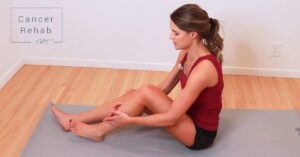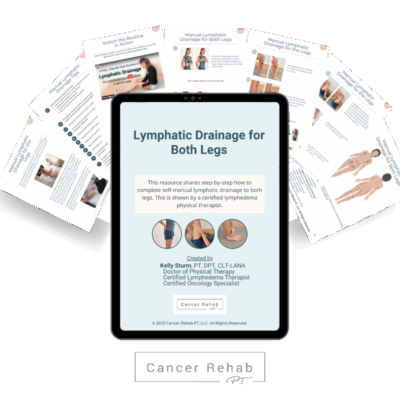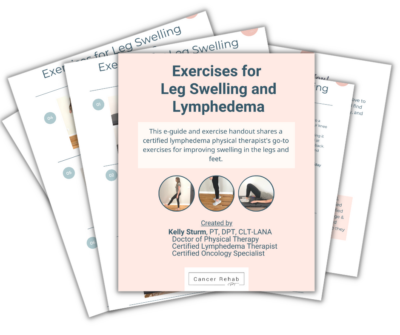Last updated on: 6/12/2025
Lymphedema is a condition characterized by the accumulation of lymph fluid, usually in the arms or legs, leading to swelling and discomfort.
It occurs when the lymphatic system, which is responsible for draining excess fluid from tissues and filtering it through lymph nodes, is impaired. This impairment can be a result of a genetic condition, surgery, radiation therapy, infection, or congenital conditions.
Lymphedema is a chronic condition, but incorporating regular arm exercises into your daily routine can help promote lymphatic circulation, reduce swelling, and improve mobility.
In this article, I’m going to share helpful information on arm lymphedema and ten arm lymphedema exercises to help you effectively manage your symptoms.
👋 Hello, I’m Kelly Sturm, a Doctor of Physical Therapy (PT, DPT) and a Board-Certified Oncology Specialist, CLT-LANA. I share helpful resources for those living with and after breast cancer and lymphedema. Subscribe to my YouTube Channel, get my free guides, or join my program Breast Cancer Rehab.
Disclosure: Links included in this blog may be affiliate links. If you purchase a product or service with the links that I provide I may receive a small commission. There is no additional charge to you. Thank you for your support!
Key Takeaways
- Lymphedema is a chronic condition, but you don’t have to accept discomfort and limitations as your new normal. There are steps you can take to reduce the symptoms.
- Integrating regular exercises into your routine can help you relieve discomfort and improve your quality of life.
- Any exercise is great, but make sure to start slow and low and gradually build up the intensity of your exercise routine to avoid injuries or exacerbating lymphedema symptoms.
Understanding Arm Lymphedema and Exercise
There are two types of lymphedema: primary, caused by a genetic condition a person is born with, and secondary, which typically develops as a result of disruptions in the lymphatic system, a crucial network responsible for fluid balance in the body.
Secondary lymphedema often arises after surgical procedures or radiation therapy, particularly those related to breast cancer treatment, which can inadvertently damage or remove lymph nodes.
The impairment of lymphatic vessels impedes the normal flow of lymph, causing a buildup of fluid in the arm tissues. This leads to persistent swelling and discomfort. In addition to the physical symptoms, developing lymphedema can also bring about feelings of frustration and self-consciousness.
Watch this YouTube Video to learn more about what causes arm lymphedema ↓
Whether you’re living with primary or secondary/breast cancer-related lymphedema, regular exercise can help you manage your symptoms and improve your quality of life.
When you exercise, the muscles in your body act like a pump to the lymphatic vessels and can help move fluid out of the swollen area. Wearing compression when exercising makes it even more effective.
Exercise Considerations for Arm Lymphedema
When starting a new exercise routine, it’s important to approach it gradually and mindfully. Starting slowly allows you to gauge your body’s response to physical activity and reduce the risk of injury or exacerbating lymphedema symptoms.
Start with gentle, low-impact exercises for just 10 or 20 minutes a day and build up to heavier weights and longer exercise times week by week. This gradual introduction helps the lymphatic system adapt to increased activity, promoting healthier fluid circulation and minimizing the potential for swelling.
10 Lymphedema Arm Exercises to Reduce Swelling and Discomfort
Nearly all types of physical activity and exercise are helpful when managing lymphedema. I recommend you choose an exercise routine that you enjoy, whether that’s walking, strength training, or yoga.
To get started, here is a simple lymphedema exercise for arms routine that you can follow. Watch me demo these exercises in my YouTube Video ↓
1. Deep Breaths
Let’s start with deep breathing to promote lymph fluid flow and help you feel more relaxed.
Place your hands on your belly and gently press inward. When you take a deep breath, you should feel your belly expand. Repeat this exercise 4-5 times.
2. Neck Rotations
To gently activate your head and neck lymph nodes, stand straight and look over your shoulder to the right and then back. Then, look over your shoulder to the left and come back to the center. Repeat this exercise 8-10 times in each direction.
3. Shoulder Rolls
Bring your shoulders up toward your ears and roll them back down. Continue to move your shoulders in an exaggerated circular motion, making the movement as large as you can. Switch the direction of the movement if it feels good to do so! Repeat 8-10 times in each direction.
4. Shoulder Circles
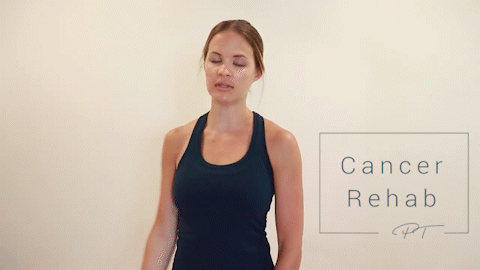
Lift one of your arms up and move it in large circles up and over your head. Do a couple of circles in different directions and switch your arms. Repeat 8-10 times on both sides.
If you experience any tightness or pain in your shoulder, adjust the motion to make the circles smaller. The goal is to go as large as you can without adding more pain.
5. Trunk Side Bends
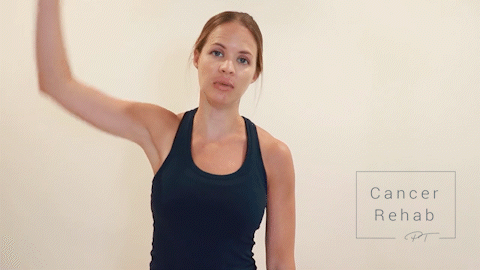
Tip your entire torso over to the side and allow for a stretch on your opposite side. Go back up and tip over to the opposite side. If you can tolerate it, put your hand over your head when you rotate for a deeper stretch. Repeat 8-10 times on each side.
6. Shoulder Retraction

Squeeze your shoulder blades together and then extend your arms out in front of you, exaggerating the motion. Move back and forth, squeezing your shoulder blades together and then extending your arms forward. The idea is to open up your chest and give your shoulders a nice stretch. Repeat 8-10 times.
7. Bicep Curls

Straighten your elbows to your sides, bring your hands to your shoulders, and then bring your hands back down. If you can tolerate it, consider adding in a bit of weight (1-2Ibs). Repeat 8-10 times.
8. Wrist Rotation
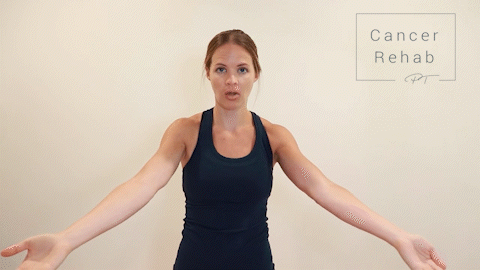
Rotate your wrists back and forth to stimulate your forearms. You can bend your elbows or do this exercise with straight arms, whatever feels comfortable. Repeat 8-10 times.
9. Wrist Circles

Move your wrists in a circular motion, then switch directions and move a few more times. You can also add a couple of ups and downs or pumps to activate and stretch your wrists. Repeat 8-10 times.
10. Grip Squeeze
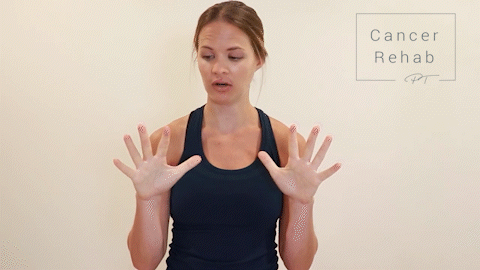
Grab an exercise ball, roll up a towel to squeeze, or simply make fists. Squeeze your fists and then open your hands all the way, straightening out your fingers. If your fingers are swollen, just go with the motion that you can tolerate. Repeat 8-10 times.
💪For more breast cancer-related arm lymphedema exercises and resources, join my program Breast Cancer Rehab.
Addressing Potential Challenges and Setbacks
Once you implement your exercise routine into your daily life, you may experience challenges like:
- Increased swelling and/or flare-ups
- Decreased mobility
- Heightened risk of skin infection
- Fear of worsening your lymphedema
Some people notice that they experience swelling even if they do minimal physical activity. In this case, remember that regular physical activity has important benefits, and try to adjust your routine to minimize swelling without stopping the exercises altogether. Consider also:
- Consulting a healthcare professional
- Focusing on low-impact exercises
- Gradually intensifying your regimen
- Using compression garments
- Adhering to proper hygiene and skin care habits
Sticking with a consistent exercise routine can be challenging, but it can also make a world of difference in your quality of life.
Final Thoughts
Arm lymphedema is a chronic condition that causes swelling, discomfort, and limited range of motion. Incorporating regular physical activity into your daily routine can help you effectively reduce swelling and manage your lymphedema symptoms.
It’s important to set reasonable expectations for yourself and start with gentle, low-impact exercises to avoid injuries or exacerbating your symptoms. You can build up the intensity of your exercises over time.
Frequently Asked Questions
What are the best exercises for lymphedema in the arm?
For lymphedema in the arm, good exercises include neck rotations, shoulder rolls, bicep curls, and more. You can get a simple arm lymphedema workout routine in this YouTube video or inside my program Breast Cancer Rehab.
How do I get rid of lymphedema in my arm?
To get rid of lymphedema in your arm, try exercising, using a bandage and arm pump, monitoring your diet, keeping your arm raised, and preventing infection.
How do you drain the lymphatic system in your arms?
Gently stretch and release the skin on your arm, starting with the shoulder and shifting down to your upper arm, to help drain the lymphatic system.
What is arm lymphedema and how can exercises help manage it?
Arm lymphedema is a condition characterized by fluid buildup and swelling. Regular exercises can help reduce the accumulation of this fluid and improve mobility.
What should I consider before starting an exercise routine for lymphedema?
When considering a lymphedema exercise routine, it is essential to start with gentle and low-impact exercises and adjust or modify your routine if any discomfort or pain occurs.

